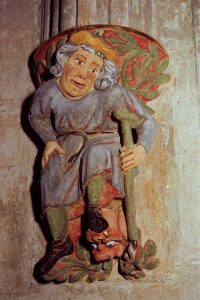 In my two previous blog posts, I spoke of Exeter Cathedral as the best example of the English Decorated Gothic style of architecture and about roof bosses as an important manifestation of this style. As well as in its roof bosses, decorated Gothic style is also exhibited in Exeter Cathedral in its carved corbels. Corbels are bracket-like blocks of stone which project from the wall to support some superincumbent weight like a vaulting shaft or rib. They are part of the structure of the building but in Exeter are beautifully carved and highly decorated just like the roof bosses. There are hundreds of corbels throughout the cathedral.
In my two previous blog posts, I spoke of Exeter Cathedral as the best example of the English Decorated Gothic style of architecture and about roof bosses as an important manifestation of this style. As well as in its roof bosses, decorated Gothic style is also exhibited in Exeter Cathedral in its carved corbels. Corbels are bracket-like blocks of stone which project from the wall to support some superincumbent weight like a vaulting shaft or rib. They are part of the structure of the building but in Exeter are beautifully carved and highly decorated just like the roof bosses. There are hundreds of corbels throughout the cathedral.
Many corbels in the nave and quire are four feet high, especially those at the level of the main arcade. Fluted shafts rise from each of these past the triforium level to an upper level of corbels from which eleven ribs spread out as they rise upward to support the vault. Exeter corbels have a great variety of relief carvings which in medieval times was brightly painted. The subjects are varied and do not always seem to be religious. The largest corbels in the first four bays at the eastern end of the quire are carved with good representations of identifiable plants found in Devon. Moving westward two changes appear. Carvings of nature become more stylised and figures begin to appear, sometimes several on the same corbel. This is continued in the crossing and throughout the nave.
The most famous corbel in Exeter Cathedral is frequently called the Tumbler Corbel. It consists of a wandering minstrel playing a viol while standing behind the head of the Exeter dog and supporting a tumbler upside down tumbling over his shoulders. The Tumbler Corbel is at the northeast end of the nave and faces a corbel on the opposite side presenting the Virgin Mary and Child with a crouching king below her. There is the suggestion that this combination of corbels was inspired by a medieval French tale of “Our Lady’s Tumbler” in which a medieval acrobat performs his act in front of the Virgin and Child as the most perfect gift he could render to them. I speak of this corbel in Plague of a Green Man, the second of the Lady Apollonia West Country mysteries.
Smaller corbels can also be of interest, such as the cripple corbel shown above. It is placed high in the north transept in the bay which connects the north aisles of the nave and quire. The crippled figure is leaning on a cane or a stick while his right foot rests on the head of a mythical animal from whose mouth sprouts foliage, much like some of the green men or foliate faces I have mentioned in other posts.
For more on the Exeter Cathedral corbels, click on
http://hds.essex.ac.uk/exetercath/docs/introduction.htm .
Tags: Chaucer's England, historical fiction, medieval mysteries